
Leila Chaoui
An expert in natural beauty remedies, our author brings a wealth of knowledge and passion for Moroccan Argan Oil, guiding readers on its benefits and versatile uses for radiant skin and hair.
Key Takeaways
Are you curious about the intricate and time-honored processes involved in creating Berber artisanal Argan oil? From the careful harvesting of ripe Argan nuts to the meticulous hand-pressing and cold-pressed extraction techniques, each step contributes to the unique flavor and quality of this precious oil. But there’s more to discover! Stay tuned to explore the fascinating fermentation and roasting process, as well as the filtering and packaging techniques that ensure the purity and authenticity of Berber artisanal Argan oil.- Berber women play a vital role in handpicking and extracting oil-rich Argan seeds, preserving cultural heritage and supporting the local economy.
- The meticulous harvesting and processing methods ensure the best quality Argan nuts for oil production, reflecting dedication and resilience.
- Skillful manual labor in oil extraction guarantees maximum oil extraction without compromising quality, showcasing the expertise of Berber women.
- Traditional processes like fermentation, roasting, grinding, cold-pressed extraction, filtering, and proper storage maintain the purity, flavor, and quality of Berber artisanal Argan oil.
Traditional Extraction Methods
 Traditional extraction methods have been the cornerstone of Berber artisanal argan oil production for generations. The Berber women, with their expert knowledge and skill, play a vital role in this process. They handpick the Argan fruit and carefully extract the oil-rich seeds, utilizing methods that have been passed down through their cultural heritage.
The process of extracting Argan oil is a labor-intensive one. The women begin by cracking open the outer shell of the fruit to reveal the seeds inside. They then hand-press these seeds to release the precious oil. This method not only preserves the oil’s natural properties and nutrients but also ensures its high quality.
It is fascinating to witness the meticulousness with which the Berber women carry out the extraction process. Their attention to detail and respect for the traditions of their ancestors is truly inspiring. They understand the importance of preserving the integrity of the Argan oil and take great care in filtering it manually. This manual filtering ensures that no impurities are present, allowing the oil to maintain its purity and therapeutic benefits.
The traditional extraction methods employed by Berber women not only contribute to the cultural heritage of Morocco but also play a significant role in the local economy. The demand for authentic, handcrafted argan oil continues to grow, providing these women with a means of supporting themselves and their families.
Traditional extraction methods have been the cornerstone of Berber artisanal argan oil production for generations. The Berber women, with their expert knowledge and skill, play a vital role in this process. They handpick the Argan fruit and carefully extract the oil-rich seeds, utilizing methods that have been passed down through their cultural heritage.
The process of extracting Argan oil is a labor-intensive one. The women begin by cracking open the outer shell of the fruit to reveal the seeds inside. They then hand-press these seeds to release the precious oil. This method not only preserves the oil’s natural properties and nutrients but also ensures its high quality.
It is fascinating to witness the meticulousness with which the Berber women carry out the extraction process. Their attention to detail and respect for the traditions of their ancestors is truly inspiring. They understand the importance of preserving the integrity of the Argan oil and take great care in filtering it manually. This manual filtering ensures that no impurities are present, allowing the oil to maintain its purity and therapeutic benefits.
The traditional extraction methods employed by Berber women not only contribute to the cultural heritage of Morocco but also play a significant role in the local economy. The demand for authentic, handcrafted argan oil continues to grow, providing these women with a means of supporting themselves and their families.
Harvesting Argan Fruits
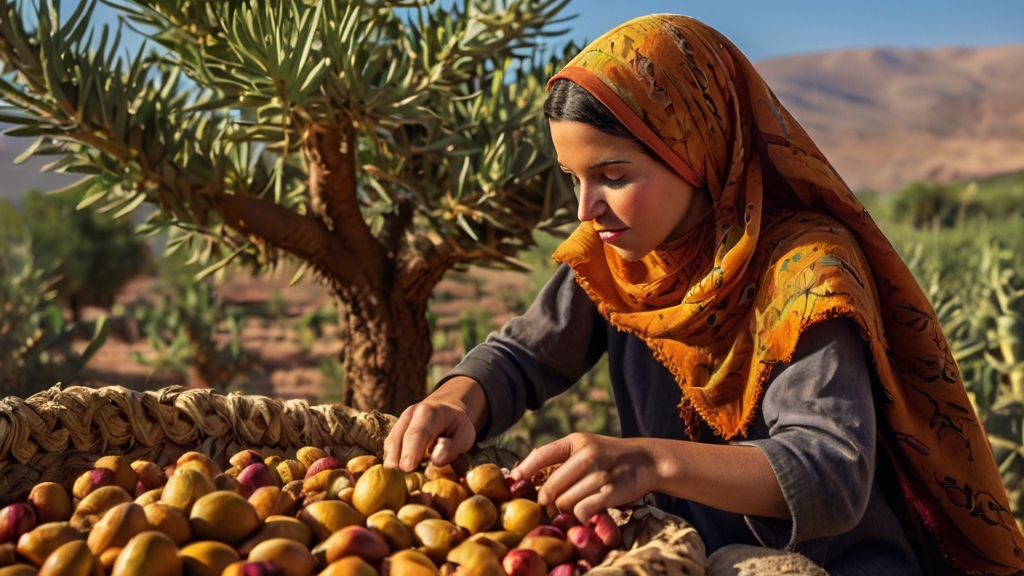 Harvesting the ripe and fallen Argan fruits is a meticulous process that requires careful collection and preservation. In the summer, when the Argan fruits ripen and fall from the trees, Berber women play a significant role in gathering them for oil production. The process begins by carefully collecting the fallen fruits from the ground. The ripe fruits are then separated to extract the valuable Argan nuts within.
The harvesting methods employed by the Berber women ensure the preservation of the Argan nuts for processing. They meticulously inspect each fruit, ensuring that only the best quality nuts are selected. This attention to detail is crucial in obtaining the highest quality oil.
The collection of Argan fruits is not only a skillful task but also an important cultural tradition. Berber women have been practicing this art for generations, passing down their knowledge and techniques to ensure the continuation of this valuable resource.
As the Berber women go about their work, one can’t help but wonder about the secrets hidden within these small, unassuming fruits. What makes them so precious? What makes them worthy of such careful collection and preservation? The answer lies in the Argan nuts they contain, which hold the key to the highly sought-after Argan oil.
The harvesting of Argan fruits is a labor of love, a dedication to preserving an ancient tradition and a way of life. It is a testament to the resourcefulness and resilience of the Berber women, who have honed their skills over time to provide the world with the exquisite Argan oil. Their meticulous collection and preservation of these fruits are a testament to their commitment to serving others, ensuring that we can enjoy the benefits of this remarkable natural product.
Harvesting the ripe and fallen Argan fruits is a meticulous process that requires careful collection and preservation. In the summer, when the Argan fruits ripen and fall from the trees, Berber women play a significant role in gathering them for oil production. The process begins by carefully collecting the fallen fruits from the ground. The ripe fruits are then separated to extract the valuable Argan nuts within.
The harvesting methods employed by the Berber women ensure the preservation of the Argan nuts for processing. They meticulously inspect each fruit, ensuring that only the best quality nuts are selected. This attention to detail is crucial in obtaining the highest quality oil.
The collection of Argan fruits is not only a skillful task but also an important cultural tradition. Berber women have been practicing this art for generations, passing down their knowledge and techniques to ensure the continuation of this valuable resource.
As the Berber women go about their work, one can’t help but wonder about the secrets hidden within these small, unassuming fruits. What makes them so precious? What makes them worthy of such careful collection and preservation? The answer lies in the Argan nuts they contain, which hold the key to the highly sought-after Argan oil.
The harvesting of Argan fruits is a labor of love, a dedication to preserving an ancient tradition and a way of life. It is a testament to the resourcefulness and resilience of the Berber women, who have honed their skills over time to provide the world with the exquisite Argan oil. Their meticulous collection and preservation of these fruits are a testament to their commitment to serving others, ensuring that we can enjoy the benefits of this remarkable natural product.
Hand-Pressing the Argan Kernels
 As you dive into the process of hand-pressing the Argan kernels, you will discover the traditional extraction method that is skillfully carried out by Berber women. With their expertise, they manually extract the oil-rich seeds from the cracked Argan nuts, allowing the oil to retain its natural flavor and aroma. This labor-intensive process is an essential part of ensuring the authenticity and quality of Argan oil.
As you dive into the process of hand-pressing the Argan kernels, you will discover the traditional extraction method that is skillfully carried out by Berber women. With their expertise, they manually extract the oil-rich seeds from the cracked Argan nuts, allowing the oil to retain its natural flavor and aroma. This labor-intensive process is an essential part of ensuring the authenticity and quality of Argan oil.
Traditional Extraction Method
Have you ever wondered how the Berber women extract the precious Argan oil from the kernels using their traditional hand-pressing method? The Argan tree, native to Morocco, provides the kernels that are carefully hand-pressed to extract the oil. This traditional method, passed down through generations, is a labor-intensive process that reflects the cultural heritage of the Berber community. The women carefully crack open the kernels and grind them by hand, creating a thick paste. This paste is then pressed to extract the oil, ensuring that it retains its original flavor, aroma, and nutritional benefits. The manual filtering during hand-pressing helps maintain the oil’s thick, dense, and raw quality. The traditional extraction method is a testament to the skill and dedication of the Berber women in preserving the authenticity of Argan oil.Skillful Manual Labor
Ever wondered about the meticulous process of hand-pressing Argan kernels, performed by skillful Berber women in artisanal cooperatives? These dedicated artisans possess the knowledge and expertise to extract the oil-rich seeds from the cracked Argan nuts with precision and care. Let’s dive into this labor-intensive task and explore the remarkable skills involved:- Delicate hands maneuvering the Argan kernels to ensure maximum oil extraction
- Applying just the right amount of pressure to squeeze out the precious oil without compromising its quality
- Skillfully separating the oil from the remaining pulp and shell fragments
- Employing traditional methods passed down through generations to guarantee the purity and authenticity of the Argan oil
- Berber women’s mastery in hand-pressing plays a crucial role in preserving the unique and time-honored process of extracting this coveted oil.
Fermentation and Roasting Process
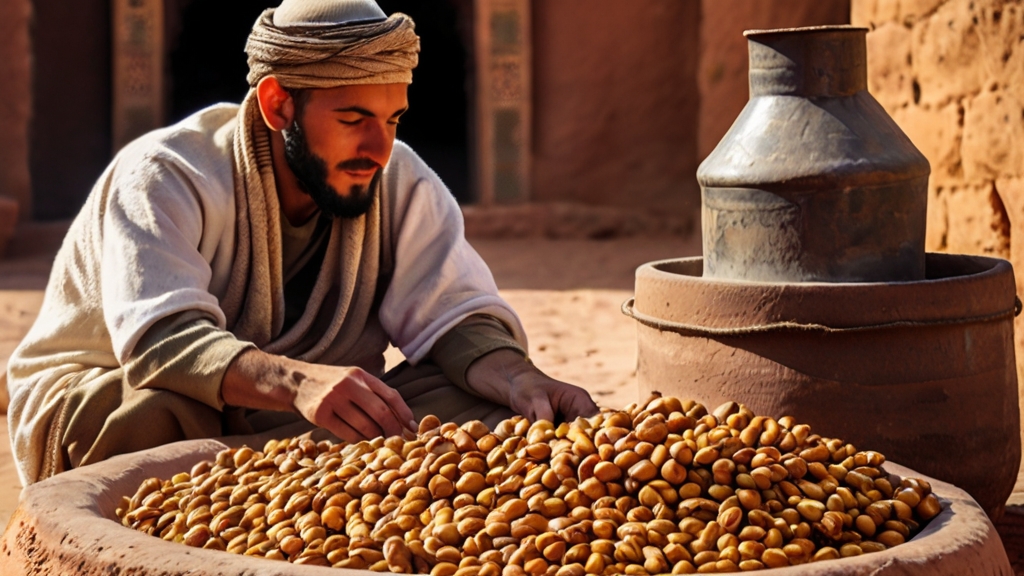 Now let’s explore the fascinating process of fermentation and roasting in the production of Berber artisanal Argan oil. Have you ever wondered how these steps affect the flavor and quality of the final product? Fermentation is a crucial step that breaks down proteins and sugars, enhancing the oil’s aroma and taste. Meanwhile, roasting the kernels not only releases the oil but also adds a delightful nutty flavor. How do the artisans ensure they achieve the perfect balance of flavors without compromising the oil’s beneficial properties? Let’s find out.
Now let’s explore the fascinating process of fermentation and roasting in the production of Berber artisanal Argan oil. Have you ever wondered how these steps affect the flavor and quality of the final product? Fermentation is a crucial step that breaks down proteins and sugars, enhancing the oil’s aroma and taste. Meanwhile, roasting the kernels not only releases the oil but also adds a delightful nutty flavor. How do the artisans ensure they achieve the perfect balance of flavors without compromising the oil’s beneficial properties? Let’s find out.
Fermentation Benefits Argan Oil
Fermentation and roasting are crucial steps in the traditional process of creating high-quality Argan oil, enhancing its flavor and aroma while adding a delightful nutty richness. The fermentation process breaks down the compounds within the Argan kernels, making it easier to extract the oil. But what exactly happens during fermentation? Here are five key benefits of fermentation in the Argan oil production process:- Enhanced flavor: Fermentation brings out the natural flavors of the Argan kernels, resulting in a more robust and delicious oil.
- Aroma improvement: The fermentation process also enhances the oil’s aroma, making it more fragrant and enticing.
- Nutty richness: Roasting the kernels during fermentation adds a delightful nutty richness to the final oil product.
- Traditional craftsmanship: Berber artisans have been using fermentation for generations, passing down their expertise to create authentic, high-quality Argan oil.
- Quality assurance: By carefully fermenting the Argan kernels, artisans ensure that the resulting oil meets the highest standards of quality and taste.
Roasting Enhances Oil Quality
After undergoing fermentation to enhance its flavor and aroma, the next step in the artisanal process of creating high-quality Argan oil is roasting the kernels to further enhance the oil’s quality. Roasting is a crucial step that adds depth and richness to the oil, making it more flavorful and aromatic. By carefully roasting the kernels, traditional Berber artisans are able to break them down and release more oil during pressing. This unique roasting process is meticulously monitored to ensure optimal results. The heat from roasting helps to unlock the full potential of the kernels, resulting in a rich, golden oil that is prized for its exceptional quality. The roasting process truly enhances the oil, making it a true delight for those who desire the best Argan oil experience.Grinding and Milling the Kernels
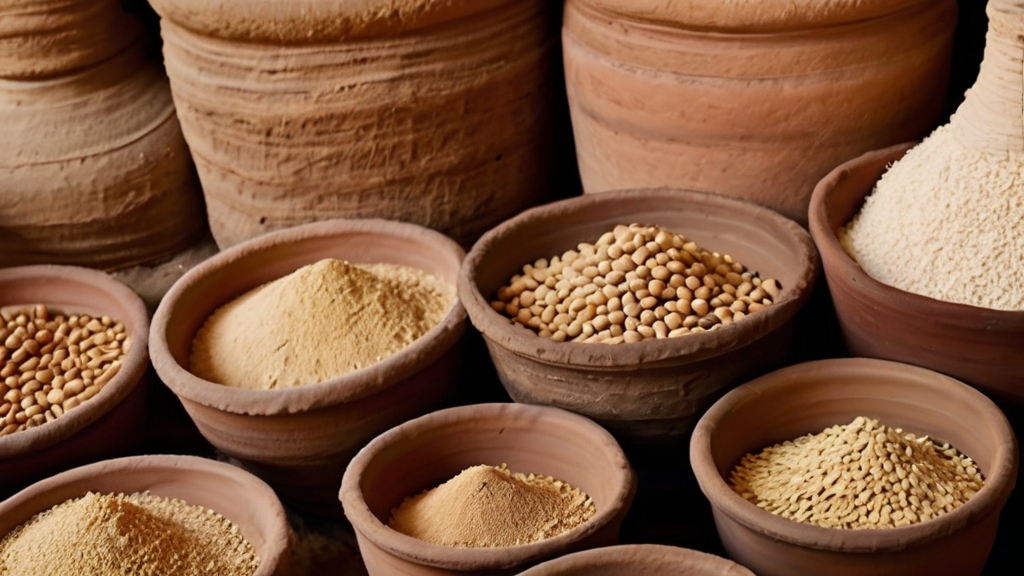 In the traditional Berber artisanal method of producing Argan oil, the kernels are meticulously ground and milled by hand in stone mills, a process that ensures the preservation of the oil’s quality and nutrients. This labor-intensive step is an essential part of the extraction process, passed down through generations in Morocco. Let’s take a closer look at how the Berber people grind and mill the kernels to produce this precious oil.
In the traditional Berber artisanal method of producing Argan oil, the kernels are meticulously ground and milled by hand in stone mills, a process that ensures the preservation of the oil’s quality and nutrients. This labor-intensive step is an essential part of the extraction process, passed down through generations in Morocco. Let’s take a closer look at how the Berber people grind and mill the kernels to produce this precious oil.
- Stone mills: These traditional mills are made of stone and have been used for centuries by the Berber people. The stones crush the Argan kernels, extracting the oil-rich seeds.
- Manual grinding: The Berber artisans take great care in grinding the kernels manually. They use their skill and expertise to ensure that the kernels are ground to the perfect consistency.
- Preservation of quality: By grinding the kernels by hand, the Berber people ensure that the oil’s quality and nutrients are preserved. This meticulous process allows the oil to retain its natural flavors and beneficial properties.
- Time-honored practice: Grinding and milling the kernels in stone mills is a time-honored practice that has been passed down through generations in Morocco. It is a testament to the Berber people’s dedication to preserving their cultural heritage.
- Labor-intensive process: The process of grinding and milling the kernels is labor-intensive and requires patience and precision. The Berber artisans take pride in their work, knowing that their efforts contribute to the production of high-quality Argan oil.
Cold-Pressed Extraction
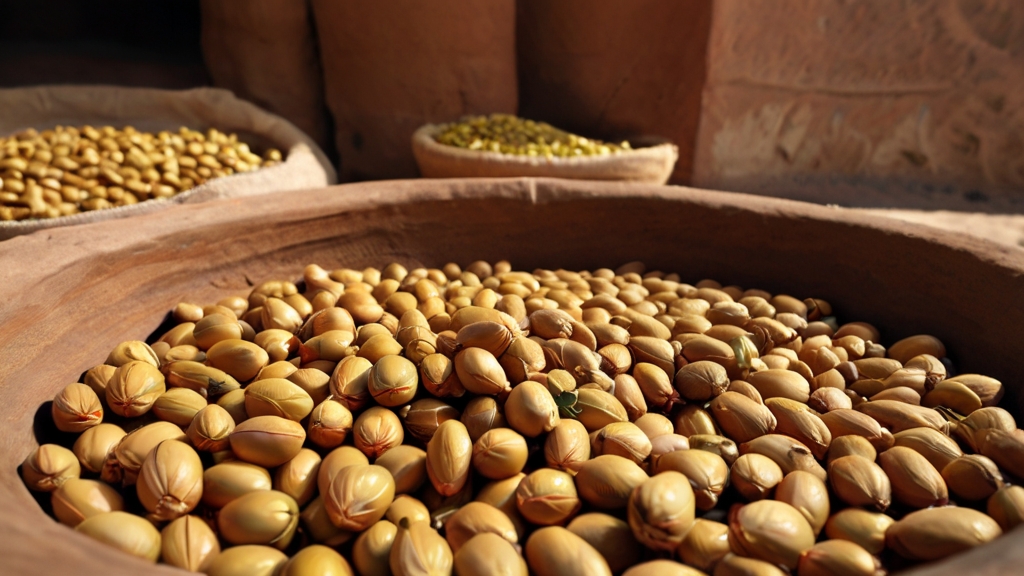 Now let’s explore the fascinating process of cold-pressed extraction, which harnesses mechanical presses to extract the precious Argan oil from the nuts, preserving its purity, flavor, and nutritional properties. Cold-pressed Argan oil is considered premium due to its natural extraction process and the retention of its beneficial compounds. This method involves pressing the Argan nuts at low temperatures, preventing heat damage and ensuring that the oil remains of the highest quality.
During cold-pressed extraction, mechanical presses are used to exert pressure on the Argan nuts, squeezing out the oil without the use of heat or chemicals. This gentle process helps retain the oil’s delicate flavor and aroma, making it ideal for culinary applications. Additionally, the low-temperature pressing method preserves the oil’s nutritional properties, including its high levels of vitamin E, essential fatty acids, and antioxidants.
The table below highlights the key benefits of cold-pressed Argan oil:
Now let’s explore the fascinating process of cold-pressed extraction, which harnesses mechanical presses to extract the precious Argan oil from the nuts, preserving its purity, flavor, and nutritional properties. Cold-pressed Argan oil is considered premium due to its natural extraction process and the retention of its beneficial compounds. This method involves pressing the Argan nuts at low temperatures, preventing heat damage and ensuring that the oil remains of the highest quality.
During cold-pressed extraction, mechanical presses are used to exert pressure on the Argan nuts, squeezing out the oil without the use of heat or chemicals. This gentle process helps retain the oil’s delicate flavor and aroma, making it ideal for culinary applications. Additionally, the low-temperature pressing method preserves the oil’s nutritional properties, including its high levels of vitamin E, essential fatty acids, and antioxidants.
The table below highlights the key benefits of cold-pressed Argan oil:
| Benefits | Description |
|---|---|
| Purity | Cold-pressed extraction ensures that the oil is pure and free from any additives or contaminants. |
| Flavor | The low-temperature pressing method retains the oil’s natural flavor, enhancing culinary experiences. |
| Nutritional Properties | The oil retains its high levels of vitamin E, essential fatty acids, and antioxidants. |
Filtering and Clarifying the Oil
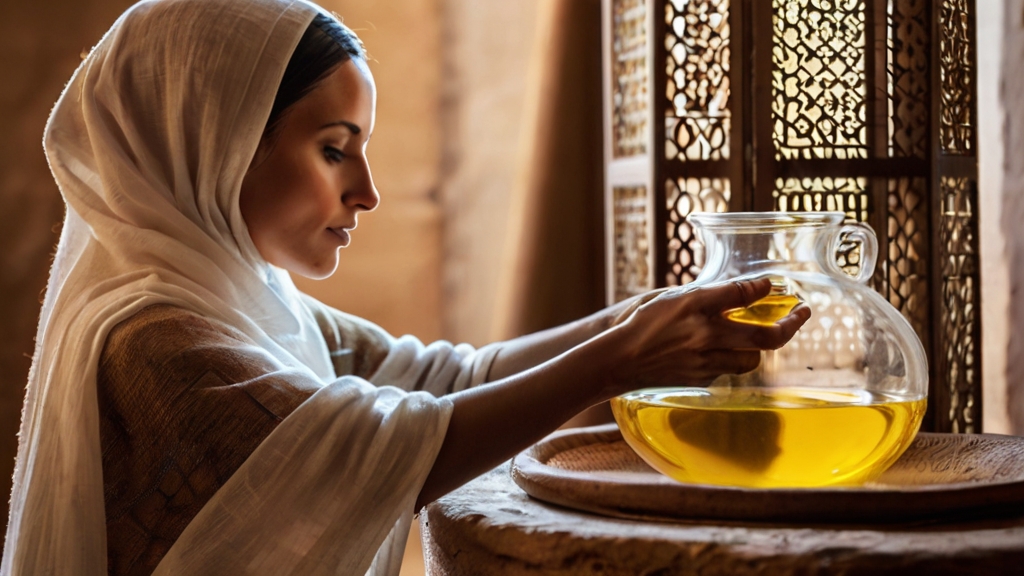 To ensure the clarity and purity of Argan oil, the next step in the process involves filtering and clarifying the oil. Filtering techniques play a crucial role in maintaining the effectiveness and quality of this precious oil. Here are some important facts about filtering and clarifying Argan oil:
To ensure the clarity and purity of Argan oil, the next step in the process involves filtering and clarifying the oil. Filtering techniques play a crucial role in maintaining the effectiveness and quality of this precious oil. Here are some important facts about filtering and clarifying Argan oil:
- Traditional hand presses made of stone are used for filtering. This method helps to maintain the oil’s high quality and preserves its natural properties.
- The filtering process not only removes impurities but also helps achieve the golden hue and distinctive aroma of high-quality Argan oil. These characteristics are highly sought after by those who appreciate the finest Argan oil.
- Impurities are carefully removed through filtering, ensuring that the nutritional properties of the oil are enhanced. This ensures that you receive all the beneficial vitamins, antioxidants, and fatty acids that Argan oil is known for.
- Proper filtering techniques are crucial in maintaining the clarity and purity of Argan oil. The artisans who produce this oil pay close attention to every detail to ensure that the oil you receive is of the highest quality.
- The filtering and clarifying process is an essential step in the overall production of Argan oil. It helps to separate any sediment or impurities from the oil, resulting in a product that is clear, pure, and ready for use.
Storage and Packaging Techniques
 After filtering and clarifying the Argan oil, the next important step is to carefully consider the storage and packaging techniques to preserve its freshness and natural properties. Proper storage and packaging are crucial in maintaining the quality and benefits of this precious oil. Let’s explore some techniques that ensure the production of Argan oil remains a cosmetic oil of the highest quality.
One common practice is storing Argan oil in airtight containers. By sealing the oil away from air and moisture, its freshness can be preserved for a longer period of time. Additionally, traditional packaging methods involve the use of dark glass bottles. This helps protect the oil from the harmful effects of light exposure, which can degrade its quality.
To further extend the shelf life of Argan oil, it is important to store it in a cool and dark place. This helps prevent oxidation and maintains its natural properties. By keeping the oil away from heat and sunlight, you can ensure that it retains its beneficial qualities.
In line with sustainable practices, some artisanal cooperatives also use eco-friendly packaging materials. This not only helps to preserve the environment but also aligns with the values of those who desire to serve others by using products that are both ethical and effective.
After filtering and clarifying the Argan oil, the next important step is to carefully consider the storage and packaging techniques to preserve its freshness and natural properties. Proper storage and packaging are crucial in maintaining the quality and benefits of this precious oil. Let’s explore some techniques that ensure the production of Argan oil remains a cosmetic oil of the highest quality.
One common practice is storing Argan oil in airtight containers. By sealing the oil away from air and moisture, its freshness can be preserved for a longer period of time. Additionally, traditional packaging methods involve the use of dark glass bottles. This helps protect the oil from the harmful effects of light exposure, which can degrade its quality.
To further extend the shelf life of Argan oil, it is important to store it in a cool and dark place. This helps prevent oxidation and maintains its natural properties. By keeping the oil away from heat and sunlight, you can ensure that it retains its beneficial qualities.
In line with sustainable practices, some artisanal cooperatives also use eco-friendly packaging materials. This not only helps to preserve the environment but also aligns with the values of those who desire to serve others by using products that are both ethical and effective.
Frequently Asked Questions
How Is Argan Oil Processed in Morocco?
In Morocco, argan oil is processed using traditional methods that have been passed down through generations. The Berber women play a significant role in the manual extraction process. First, ripe argan nuts are hand-picked from trees. Then, the nuts are de-pulped and crushed in hand mills. The oil is carefully collected and stored in airtight containers. These traditional argan oil extraction methods help retain the oil’s original flavor, aroma, and beneficial properties. The oil is widely used for its numerous benefits and uses.What Is the Difference Between Argan Oil and Moroccan Argan Oil?
The difference between argan oil and Moroccan argan oil lies in the geographical origin and production methods. Moroccan argan oil specifically refers to oil produced from the Argan trees in Morocco, known for its high quality and authenticity. It is hand-pressed by Berber women using traditional methods, ensuring its premium quality. Moroccan argan oil offers diverse benefits for both culinary and cosmetic purposes, making it a valuable ingredient in various products. Its rich golden color and nutty aroma add to its allure.What Are the Steps Involved in Extracting the Oil From the Argan Tree Kernels?
To extract oil from argan tree kernels, you follow traditional extraction methods. First, you harvest the ripe fruit and collect the hard nuts. Then, you crack open the nuts to access the oil-rich seeds inside. Next, you hand-press the seeds to extract the precious argan oil. After that, you filter the oil to remove impurities and enhance its clarity and nutritional properties. This labor-intensive process preserves the tradition and benefits of argan oil.Why Is Moroccan Argan Oil so Expensive?
Moroccan Argan oil is expensive due to various cost factors and production methods. The labor-intensive process of hand-harvesting and hand-pressing the Argan nuts contributes to its high cost. Additionally, the limited geographic distribution of Argan trees in Morocco adds to its rarity and exclusivity. Traditional extraction methods, involving manual labor and time-consuming processes, also contribute to the premium price. Despite the challenging production methods, the high demand for Argan oil in the cosmetic and culinary industries drives up its market value.Related Articles
Traditional Argan Oil Uses by Natives
Discover the astonishing array of traditional Argan oil uses by natives, from culinary delights to medicinal wonders, that will leave you amazed and craving for more.
UV Absorption Rate of Argan Oil
Get ready to uncover the surprising truth about the UV absorption rate of Argan Oil, and how it could revolutionize your sun protection routine.
Berber Argan Oil Production Techniques
Discover the intricate 'P'rocesses behind Berber Argan oil production, and unravel the secrets to its exclusivity, cultural heritage preservation, and high value.


